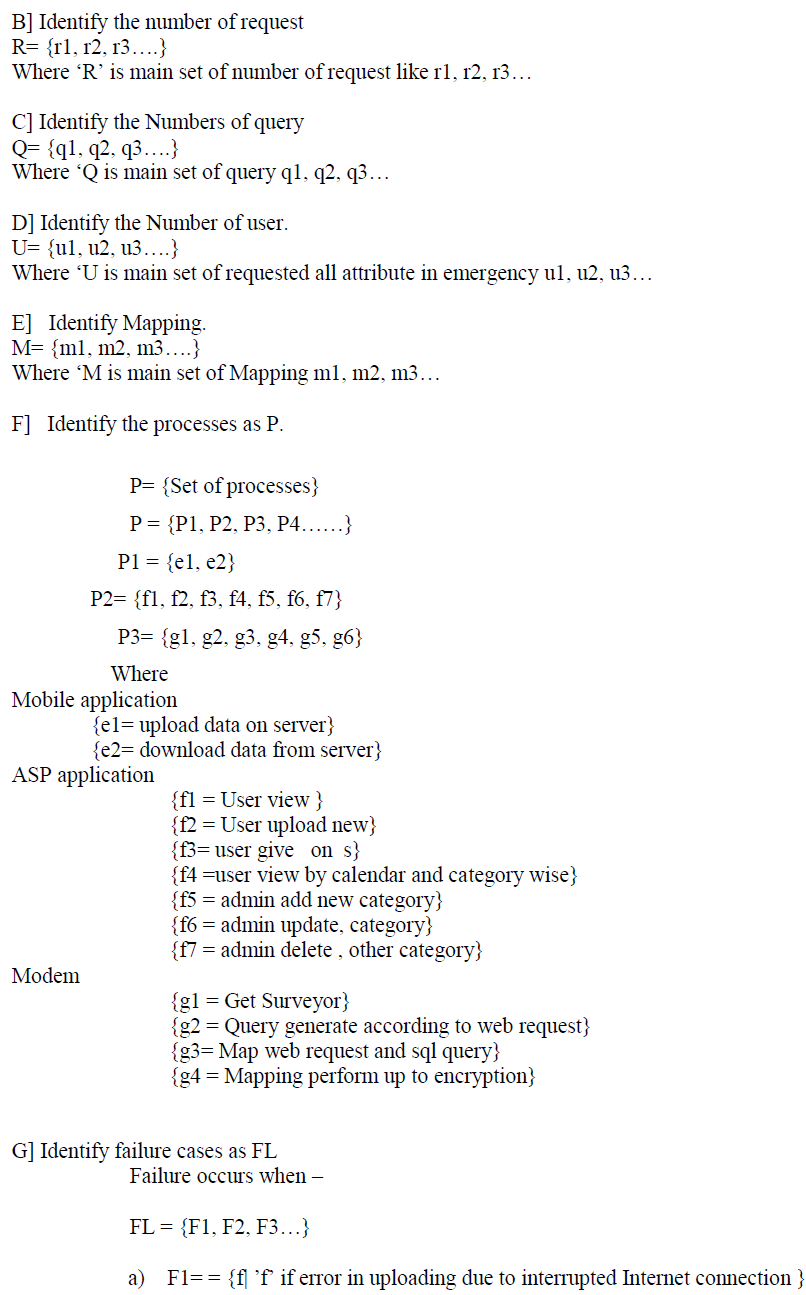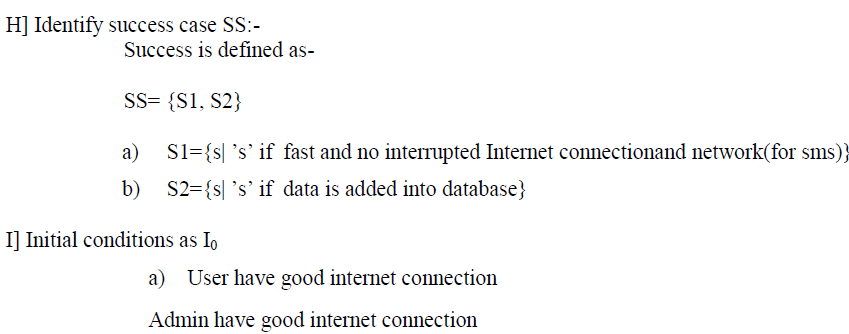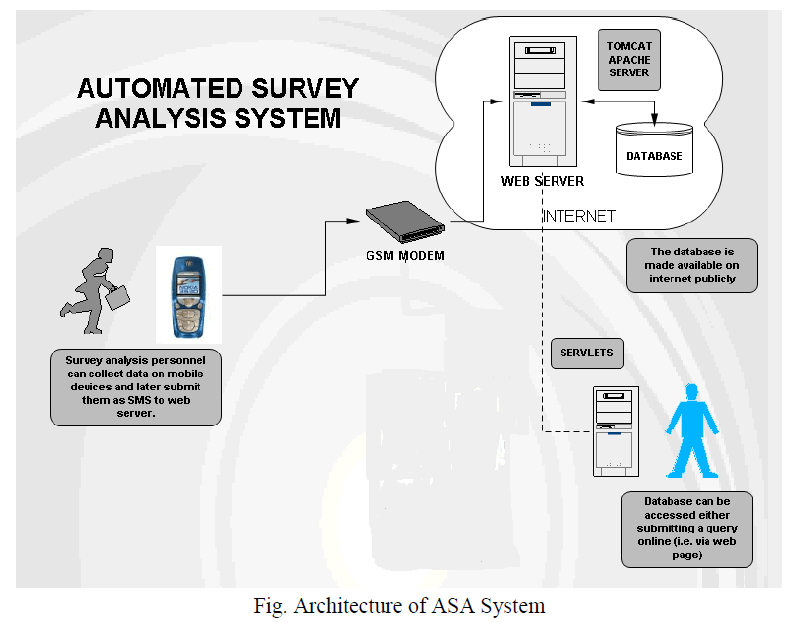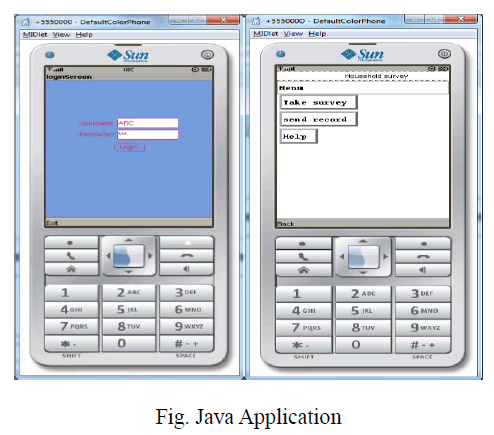ISSN ONLINE(2320-9801) PRINT (2320-9798)
ISSN ONLINE(2320-9801) PRINT (2320-9798)
Prof. Arti Bhore1, Mr V.V. Mane2, Mr S.B. Poul3,Mr V.G. Patil4,Mr S.S. Patil5
|
| Related article at Pubmed, Scholar Google |
Visit for more related articles at International Journal of Innovative Research in Computer and Communication Engineering
Automated Survey Analysis System mainly emphasizes on analysis of the surveyed information through a mobile device. This project also allows surveyor (person who takes the survey) to record survey on mobile instead of using bunch of papers. When there is availability of network connection, he will be able to upload that information on server using GSM modem. Server with the advance features manages the database and displays the result in the frame of simple yet user-friendly graphic user interface. The implementation of web pages is to display the survey result and extra information queries. The database has encryption- decryption, authentication and authorization.
Keywords |
| Java Enabled Mobile, GSM modem, Server,ASP.Net, MySQL… |
INTRODUCTION |
| Conventionally the survey is taken on the paper with filling in the detail database of the survey which mandates carrying the stuff from one place to another. This carrying of bunches of paper become overhead. Later on it has been surveyed on the laptops, which consumes lots of cost. Thus we have decided to create a mobile application such that we can directly have the survey into our mobiles. And it is very easy to carry a mobile rather than that of carrying bunches of paper. The surveyor firstly installs the application and then applies for the authentication. He will take whole survey by filling the database form and then save into the mobile. When he comes under the network range then he will send this database to the GSM modem via encrypted text message. A GSM based survey analysis system has two major technologies behind it, primary being the “GSM” and secondary one is the controller or processor. GSM (Global System for Mobile Communication) is a standard set used to describe protocols for digital cellular networks. The processor or the controller works as a central core for functioning of the automated process after it has been initiated by the GSM based device and finally presents the output to the device. This paper contains five detailed comparative study of GSM based survey analysis approaches.Now a day, a Bluetooth module is also interfaced with the processor/controller for simplifying the mobile device complications. It gives a detailed study of the advantages and disadvantages of the various technologies proposed by the systems in the papers understudy. |
| The aim of our system is to replace the conventional way of surveying techniques by using an innovative way for the same using means of technology and thus cut down the expenditure of resources in terms of personnel, time and finances |
II. MATHEMATICAL MODEL |
Set Theory Analysis |
| A] Identify the survey Details |
| A= {d1, d2} |
| Where „D‟ is main set of ASA like d1, d2 |
| D1=Mobile application |
| D2= ASP application |
 |
 |
III. BLOCK DIAGRAM |
 |
| From the above figure we can say that the GSM modem became the heart of the system. Surveyor taking survey of and sending data to the server through GSM modem via encrypted message. This information can be shown on the internet by using web design |
| Five phases of ASA system |
| 1. Surveyor taking up the survey. |
| 2. Sending it to the GSM modem as a message. |
| 3. GSM modem as to accept it and encrypts and send to server using AT commands. |
| 4. Server already configured will fetch the query and store. |
| 5. Redesign and display. |
REQUIREMENTS |
| A) Hardware Requirements |
Server |
| It will used to host the Database to interact with system. It will also host web application to display the final results, which will be used by mobile users for actual services. |
Java Enable Mobile |
| For any surveyor, it would be easier to carry a mobile instead carrying a bunch of papers and other things. He/she only needs to log in the application and simply collect the information on our developed application inside the phone, and at the end of the day or after finishing the work one can send the survey record to the GSM modem in the form of encrypted text message. |
GSM modem |
| To receive the message from surveyor‟s mobile, and send to the server using AT command through encryption and decryption techniques |
B) Software requirements |
Operating System: |
| windows XP/ Window Vista/ Windows7. |
SDK/IDE: |
| ▪ Microsoft Visual studio 2010 |
| ▪ Java SDK 2.0 for the front end |
| ▪ J2ME Emulator |
| ▪ MySQL for Database Handling as back end |
| C) Functional requirements |
| The Functional Requirement documents the operations and activities that a system must be able to perform.Functional Requirements should include the following: |
| • Descriptions of survey tables to be taken |
| • Descriptions of operations performed by each screen |
| • Descriptions of work-flows performed by the system |
| • Descriptions of system reports or other outputs |
| • Who can enter the data into the system? |
| The functional specification is designed to be read by a general audience. Readers should understand the system, but no particular technical knowledge should be required to understand the document. |
Module1: |
| GUI design of the project and AT command implementation for data encryption and decryption. |
Module2: |
| Encrypting and decrypting the message and after sending to server. |
Module3: |
| Creating the space on database and according to survey allowing the GSM to send surveyed data. |
Module4: |
| Finalizing all the requirements showing on web portal as result, giving the special access over the data to the user. |
D)NON FUNCTIONAL REQUIREMENTS |
Performance Expectations |
| All the actors will be able to accomplish its need. |
User and human factors |
| Surveyor- Should be able to create account and have knowledge to use all the authority given. Administrative Service Provide- Should be able to provide sufficient data storage capacity. |
Physical Environment |
| Multiple user application will be used like for login, take survey, store and send, apply for general user access and prevented from accessing data. |
Interface Requirements |
| Validations and updates from the server give the appropriate updates about the Information stores in it after an action. |
Security Requirements |
| Validations, error preventing algorithms in application includes security for the system |
V. SCREEN INFO & DATABASE |
 |
A) Authentication |
| This is the first &most important step after installing the application. The surveyor has to conform by entering user name and password for the authentication. If the entered information is correct then he will access for next data. If it is not correct then it will display as invalid user. |
B) Surveyor info table |
| This table shows the details of the survey like district info, village info, unique ID, family members and their relationships, age, total income, education etc. |
C) Save-Send |
| After filling the total database user can send to the GSM modem for storage into server. He also can save if into mobile if there is lack of network. |
| This application increases the speed of survey; cost of this application is also very low and data can easily editable. It can be expandable at any limit like villages to districts, states to countries etc. |
| This applications have some limitations such as this system will not work for the mobile device which is not having java enabled facility. Thesystem will fail if in case server has any problem. |
VII. CONCLUSION |
| There is an urgent need for a system that makes the survey easier and burden free from bunches of paper. With the recent advancement of technology it has become necessary to survey fastest and without any complexity. The approaches studied had various pros and cons in the time required for operations or complexity or feasibility and user interactions. With technology advancing everyday new techniques have been implemented for further minimizing the survey process like using prebuilt mobile phone or standalone application software for conduction the survey processThus we have developed a Social application that will help in taking the survey through mobile instead of paper and pencil interview and it is one of the efficient techniques than existing one. Also it reduces the data entry work.It enables any user to get information just by entering particular query. |
| Thus we can conclude that, survey enhances the technology use rather than that of using the bunch of papers for survey, to reduce the complexity and increase the speed of survey. |